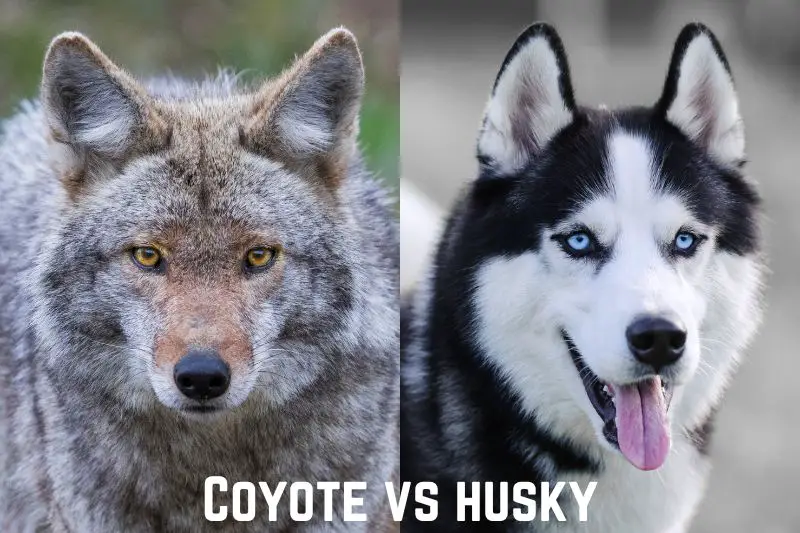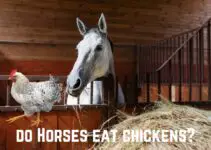Are you wondering what differentiates these two canine breeds: coyote and Husky? Both look almost similar, but they have some differences.
Worry less if you find knowing the difference between coyote and husky challenging. This article will help you uncover useful insight to distinguish between the two dog-like breeds.
Read: Coyote vs Hyena: Who Will Win?
Contents
What is Coyote?

Coyote is a species of canid native to North America. They are known for their adaptability and intelligence and are often portrayed in popular culture as cunning and wily animals. Coyotes are smaller than their close relatives, wolves, and are typically about the size of a medium-sized dog.
They have a varied diet, including small mammals, birds, reptiles, and fruits and vegetables. Coyotes are also known for their distinctive howl, which is often heard at night.
What is Husky?

Husky is a dog breed that originated in Siberia’s Arctic regions. They are known for their thick fur, which helps them survive in cold climates, and their striking blue or brown eyes. The Chukchi people originally bred huskies for use as sled dogs, and they are still used for that purpose today.
They are highly energetic and require a lot of exercise and attention, making them a popular choice for active families. Huskies are also known for their friendly and outgoing personalities, and they get along well with children and other pets.
Differences Between Coyote vs Husky
Differentiating the two breeds is simple. Observe the physical characteristics like body shape, weight, and, most of all, their behavior. Let us take our main focus on some of their key characters.
| Coyote | Husky | |
|---|---|---|
| Family | Canidae | Spitz |
| Length | About 124 cm (48 in). | Approximately 77 to 88 cm |
| Height | About 24 inches at the shoulder | Approximately 53-62 cm high (21.5’’-23.5’’) |
| Lifespan | 6 to 8 years | 12 to 15 years |
| Weight | 20-50 pounds | Approximately 60 pounds or less |
| Food | Rodents, fish, amphibians, insects, birds, thrashers, turkeys, and sparrows. | Little protein and more calories |
| Habitat | Part of Alaska and the Great Plains in Central America | Wilds of Alaska and Siberian Tundra |
| Bite Power | Approximately 89 PSI | Approximately 325 PSI |
| Speed | 30-45 mph | 30-40 mph |
| Color | Gray, black, and tan, | Black-and-white pattern |
| Eyes | Brown, blue, or black eyes | Blue or brown eyes |
| Sound | Short howls | Screaming, yelping, whining, howling, |
Family
Coyotes belong to a family known as Canidae. Its scientific name is Canis latrans. Some people refer to coyotes as brush wolves or prairie wolves because they look almost similar to wolves, except they are small and more petite than wolves. You can easily recognize a coyote because it has pointed ears, a dropping bushy tail, and a slender muzzle.
On the other hand, the husky is a dog breed that belongs to Spitz genetic family. Huskies are dog breeds surviving in the Polar Regions. The Siberian husky, for example, is a working sled dog breed that is medium-sized.
They have a double coat with thick fur to help them survive the freezing temperatures. You can easily recognize them because they have distinctive markings with erect triangular ears.
Length
Another key difference is the length. Like other dog breeds, coyotes come in many sizes. But the male coyotes are much longer than their counterparts, the females. However, the average length of a fully-grown coyote is about 124 cm (48 in).
Huskies come in different types, but let us consider the Siberian husky for our sak—Siberian husky measures approximately 77 to 88 cm. A husky is not as long as the German shepherd breeds; it is medium-sized.
Height
Depending on the species, there is a local variation in the size of the coyotes. However, a fully grown coyote stands about 24 inches at the shoulder. There are 19 subspecies of coyotes. They are similar but vary in size, the shortest being the plain coyotes. They are in Texas, Colorado, Oklahoma, and central Canada.
Husky is not a giant dog breed. A fully grown male husky can measure approximately 53-62 cm high (21.5’’-23.5’’). Their female counterparts can measure 50-55 cm tall (20’’-22’’).
When you view a standing husky from the front, its legs are straight and parallel, while its elbows are close to its body. The distance from the ground to the elbow is slightly more than from the top to the elbows.
Weight
The size of coyotes depends on several factors, like age, sex, healthiness, and many others. But most coyotes weigh between 20-50 pounds. A healthy newborn can weigh 6-10 ounces or even a half pound. There are scenarios where wild coyotes can weigh up to 100 pounds.
You’ll find plenty of food in the places where such coyotes are found, and the environment is favorable, free from diseases at that particular time.
Also, the husky weight depends on the same factors as in coyotes. A fully grown husky can weigh approximately 60 pounds or less if you give a proper diet and the right healthcare. Huskies are relatively small. If you have a husky, you know how expensive they are to maintain.
You need to conduct frequent checkups with the veterinarian to help keep a close eye on any potential disease. And also need to give a proper diet for a proper husky breed. Huskies are very prone to obesity and can even suffer thyroid infections.
Read: Lynx vs Wolf: Who Would Win in a Fight?
Habitat
Coyotes can occupy any habitat but prefer open places like deserts and prairies. Most of these habitats are found in the southern part of Alaska and the Great Plains in Central America.
Coyotes once occupied the Appalachians, but you can now find them in most places throughout Canada and the United States. They also occupy places near food sources, like opening tunnels that dispose of city garbage.
Husky’s natural habitat is the cold climate, like in the wilds of Alaska and Siberian Tundra. Husky is well adapted to survive this climate. They are double-coated to prevent them from freezing in the cold. Under extreme cold conditions, they borrow holes to get shelter. Other dog breeds can freeze to death in these regions.
Another welcoming characteristic for these breeds is that they can be domesticated and are now found in some of the warmer climates. However, they need extensive care because they can overheat from the double coating layer.
Food
Coyotes are omnivorous, although they belong to the canine group. But their main diet varies depending on the type of food present. They mainly feed on animals like rodents, fish, amphibians, insects, birds, thrashers, turkeys, and sparrows. Don’t forget that they are also fierce predators. Sometimes, they hunt down large mammals like bighorn sheep, white-tailed deer, bison, and moose.
On the other hand, for the pet coyotes, consider giving them raw bones, a pancreas, veggies, eggs, fish, and a spleen. You cannot go into the wild to hunt down bison for your pet coyote, right?
Also, the type of food to give your husky depends on its age. Husky seniors, adults, and puppies have different nutritional needs. You should give the senior huskies little protein and more calories while giving them balanced dog food for the adults. Avoid giving the puppies too much calcium because it can permanently cause hip disorders.
Bite Power
If coyotes can tear out the skin of a bison, how strong are their jaws? Like wolves, coyotes also have slightly strong jaws. They can generate a biting power of approximately 89 PSI. The strongest punch comes from the law jaws. Although they are shy animals, never threaten them, especially when having their young ones.
On the other hand, huskies, like any other dog breed, have a very strong biting power. The average known biting power of a husky is approximately 325 PSI. However, it’s rare for them to attack unless trained.
Husky, especially the Siberian breed, is a very friendly pet and is among the best for domestication. They are very intelligent, and you can take the shortest time to train them when compared to pet coyotes.
Speed
A fully grown coyote can reach a speed of 30-45 mph when running, especially when charging at prey. Coyotes are also good swimmers. A coyote can swim at a speed of 1 km/h. The strong hind legs have muscles that help deliver power when swimming or running.
Husky on the other hand, the Siberian husky is the fastest breed in the family, reaching up to 30 mph. Both front and hind limbs are strong and provide excellent stamina. Siberian husky can run to around 160 miles in a day at an average speed of 8 to 12 mph.
Color
Coyote coats consist of various colors, including gray, black, and tan, but sometimes they can lie from dark gray to strawberry blond.
The common pattern found in Siberian huskies is the black-and-white pattern. The black color can sometimes vary in spread and intensity. In some huskies, the black pattern lightens to become silver-like.
The gene making up the color pattern is very complex to study. It can take time to master to produce a certain pattern consistently.
Feet
The paw prints of a coyote are oval. They look almost similar to those of a dog, with each pad having a toe. However, their heel impression is more prominent than those of a dog. For the sake of dogs, there is a relatively small V-shape gap between the toes than those of a coyote.
Huskies have strong and sturdy, slim paws. The side of the toes is covered with fur to help them keep the feet warm due to the freezing temperatures. They have a very active lifestyle; we expect their pads to be strong and tough. You can also notice a slight web in between the toes.
Sound
Coyotes make short howls. They normally rise or fall the pitch, yap, bark, and also produce staccato yips.
Huskies, on the other hand, have different communicative vocalizations. They include screaming, yelping, whining, howling, and other sound ranges that you will consider them communicating.
Eyes
Coyote eyes are rare to find them looking like those of other animals. Say they are one in a million. They strictly fall within a golden spectrum color. The young coyotes are born with bluish eyes, which turn yellow and eventually golden as they grow.
Huskies, on the other hand, have particolored eyes. It means that there are two colors in the same eyes. You can also find one brown eye and one blue eye on the same husky. But huskies generally have blue eyes or brown depending on the pattern color.
Senses
Coyotes have an excellent sense of smell and keen hearing; they are also nocturnal and can see in the dark. These smart senses help them hunt in the dark.
Another amazing trait is the sense of smell of the husky; they can even follow a trail that is of several weeks old. They also possess a remarkable sense of smell. The greatest sensory organ of a husky is its nose.
Read: Leopard vs Hyena: Who Would Win in a Fight?
Who Would Win in a Fight? Coyote or Husky
A husky will always become victorious in a fight with a coyote because they have very strong jaws with a biting power of 325 PSI, whereas coyotes only have 89 PSI.
The paws of a husky are also very tough and firm; they have the greatest stamina because they spend most of their time active, unlike coyotes, which become active at night.
Conclusion
Both coyotes and huskies belong to the canine group but are of different families. Coyotes belong to the Canidae family, while husky is Spitz. Huskies are a dog family living in cold climates. They have a double coating to help them survive the warm environment.







